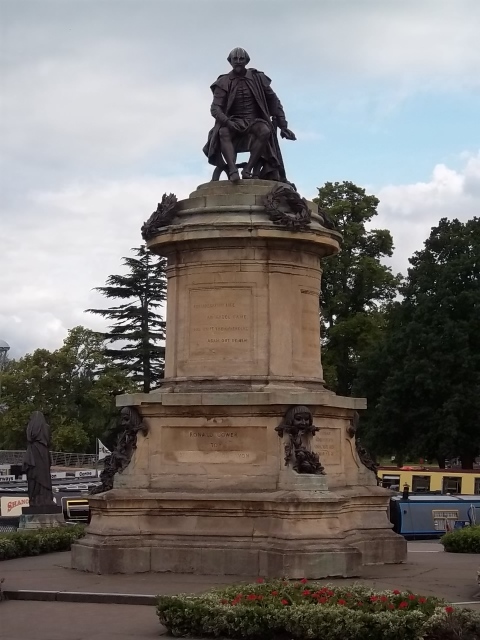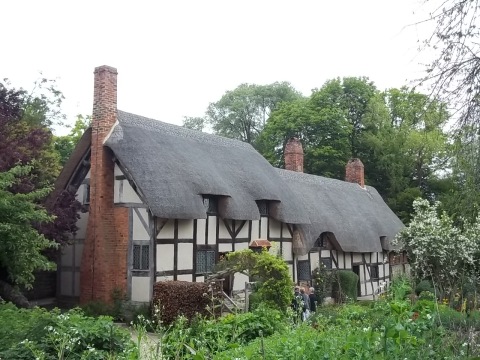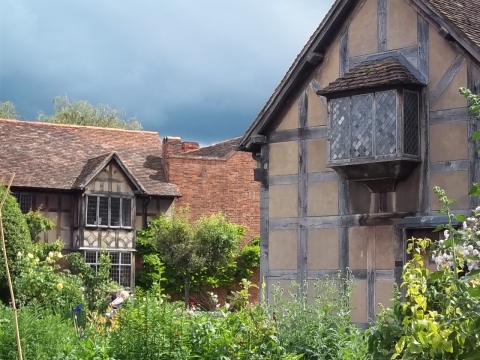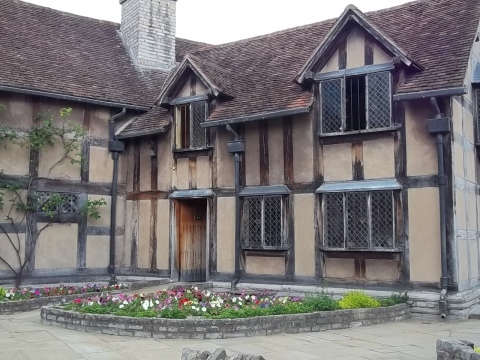In the land of Shakespeare
June 16, 2011 § 1 Comment
For the past two days, I’ve been happily visiting Stratford-upon-Avon, the birthplace and home of Shakespeare. The visit started off fabulously with my viewing of Macbeth, and it’s continued to be great. It’s been so great, in fact, that I just decided to stay another night. Three nights in one place! It’s luxurious and relaxing not to be running for a train all the time.
I started yesterday by visiting the tourist information office and picking up a couple of walking tour guidebooks. I’m pretty over-ambitious in what I think I can do in a day, so I also bought myself a ticket on a hop-on-hop-off tour bus that hits many of the major attractions in the town and surrounding area. As a combination with that ticket, I got a discounted ticket for a boat cruise along the Avon River. I had hoped to catch the 11:00 walking tour (2 hours), too, but by the time I finished at the tourist office it was ten past. It’s a good thing I missed the walking tour, however, because I ended up with more than enough to do in a day.
The next bus to leave my area of town was at 11:25, so I spent a few minutes browsing in shops and checking out all the various restaurants in that area, scoping out a place for lunch later. When the bus did come along, I hopped on, and off we went. The tour bus meanders through the city before heading a little ways out into the country to Anne Hathaway’s cottage and Mary Arden’s farm, then it returns to the city and starts over again. Although I got on at one of the first stops in the city, I didn’t get off to go into anywhere until I got to Anne Hathaway’s cottage.
Anne Hathaway was Shakespeare’s wife. She lived in this cottage a few miles outside Stratford with her parents, and she was surprisingly old to be unmarried (for the time). At the time of their marriage, Anne was 26 and Will only 18. The story goes that Shakespeare applied for a rushed marriage license (the traditional license taking months to procure, apparently), and his first daughter was born only six months after he and Anne were married. There’s a bit of scandal for you.
Anne and Shakespeare moved into Shakespeare’s parents house when they were married, and descendants of Anne’s family lived in the house for a couple more generations (to the best of my knowledge). I’m not sure when it formally became a historic site.
The cottage was wonderful. It is surrounded by beautiful, lush gardens, and being inside the house itself is like going back in time. Everything is on a tiny scale in comparison to today’s standards, including beds that can’t have been even 5 feet long and doorways that even I had to duck to go through. It’s pretty wondrous to imagine that Shakespeare walked on those same floorboards, put his hand on the same stair rail, was alive there. It’s kind of mind blowing.
The next stop on the bus tour was Mary Arden’s farm. Mary Arden was Shakespeare’s mother, wife to John Shakespeare. The farm was her family’s farm, and she moved into her husband’s home as soon as they were married. The farm was interesting, and the farmhouse had many of the same aspects of time travel as Anne Hathaway’s cottage. The farm was markedly different, however, because they have actors who wear period dress and go about daily life as would have been done in the time of the Tudors. It was interesting to see, although it was geared toward an audience about a third my age. I didn’t spend long there, and I didn’t feel the same tug of history that I had felt at Anne Hathaway’s cottage.
From the Arden farm, the bus made its way back into the town center, where I disembarked to find lunch. I found it at a nice restaurant claiming to serve “traditional English” fare. I ordered shepherd’s pie made with lamb, which was delicious and wonderful after the windy and cold trip on the open top of the bus. I finished lunch around 3 and headed up the street to Shakespeare’s birthplace.
The Shakespeare’s birthplace attraction consists not only of the house where Shakespeare was born and lived for many years but also includes an exhibit about Shakespeare created by the Shakespeare’s Birthplace Trust (this is the organization that manages all 5 of the Shakespeare houses – Anne Hathaway’s cottage, Mary Arden’s farm, Hall’s Croft, New Place, and, of course, the birthplace itself) which consists of a handful of videos and exhibit rooms. One must go through this segment before entering the birthplace house, and it’s very enjoyable. I wished it had been longer!
The birthplace itself is the home where John and Mary Shakespeare lived with their children (they had 8, although only 5 of them lived to adulthood). Shakespeare was, of course, born there, and he lived there well into his adulthood after he and Anne Hathaway were married. The house was interesting, with costumed tour guides supplying biographical information at every turn. It was very enjoyable to visit.
From there, I traveled to Hall’s Croft, the home and medical practice of John Hall, husband to one of Shakespeare’s two daughters. Hall’s Croft was less interesting to me, although it was neat to read about some of the cures he used.
After Hall’s Croft, I decided to deviate from the bus tour a bit and I headed to the Holy Trinity Church just a couple of blocks from Hall’s Croft. Holy Trinity Church is where Shakespeare was buried. Knowing that buying a burial plot in the cemetery would give him only 20 years of interment (after which his remains would be dug up and burned in a bonefire – bonfire, by today’s usage), Shakespeare had himself buried under the chancel of the church. The church is still in operation today, and alongside Shakespeare are buried Anne Hathaway, one of Shakespeare’s daughters, and her husband. Inscribed on Shakespeare’s grave is a curse upon anyone who should move his bones.
I was shocked by my reaction to visiting Shakespeare’s grave. The church was beautiful, with high arches and beautiful stained glass windows everywhere you look. I walked up to Shakespeare’s grave right at 5 o’clock, so I stood looking at his grave while the church bells rang above me. In that moment, I was overcome by something, not sadness exactly, and I nearly cried. I left the church with my throat aching with suppressed tears.
Thinking to lighten my mood, I decided it was time for the river cruise. The information pamphlet noted that the last cruise left the dock at 5:30, so I headed in that direction and arrived at 5:20. The waiting area looked closed up, and the boat, although running, also looked like it was done for the night, which chairs stacked on tables, etc. I checked the departure time board and found that the last cruise had left at 5:00. I checked the pamphlet again, and it most definitely said 5:30. I was pretty irritated, but my plan is to speak with someone about it this morning in the hopes of still getting to use my ticket.
I think I will also visit New Place, the final home of Shakespeare before his death. Additionally, I’ll probably do one of the walking tours that I bought myself a guide to, or, if I’m speedy, I might catch the 11am guided walking tour. I’m really glad I’m staying for another day, although it may mean that I miss out on other sights that I might have enjoyed seeing. I just can’t help how much I’ve been loving basking the Shakespeare-ness of this town! It’s somewhat amusing that I’m here, reveling in Shakespeare, when just a little over 3 years ago I would have sworn up and down that Shakespeare was overrated and not worth such worship. During my senior year of college, I had to write a paper about Shakespeare. Our assignment was to write something original about Shakespeare, which, of course, is virtually impossible to do (especially in a 10 page, undergraduate research paper). I did my damnedest, however, and in the process I fell in love with King Lear, or, more specifically, Edgar. Ever since, I’ve been an undying fan of the Bard, and although I’m in no way an expert, I have a huge appreciation for his contributions to our culture.

The Shakespeare memorial... with added decoration from some disrespectful (if talented with their aim) birds.
One point that was repeatedly made during my day on the town is just how much Shakespeare influenced the English language. We use his words every day and don’t even realize we are doing so. For instance: frugal, monumental, unreal, jaded, discontent. Of course, he created a number of less common words too, my favorite of which is honorificabilitudinitatibus (and yes, I can pronounce it). But the point is that Shakespeare is in your life whether you want him to be or not. Not to mention that his plays are such a huge part of our cultural frame of reference, even if we haven’t read them. Who doesn’t know that Romeo and Juliet were star-crossed lovers? Who hasn’t heard “to be or not to be, that is the question” or “double, double toil and trouble”? Sure, they are hugely cliched phrases, but if you really think about it, it’s hard to imagine culture today without Shakespeare (consider, for instance, all of the movies and plays and musicals that are reinterpretations of Shakespeare’s stories). And he was just a guy, writing, trying to make a living. Sure, he was a genius, but he was also just a guy. There’s no way he could have imagined what an important figure he’d become in the world, and sometimes I wonder how it happened. History, culture, literature – they all have so many blind spots, so many places where people slip through the cracks. Aren’t we lucky he wasn’t one of those people?










[…] In the land of Shakespeare (everythinginflux.wordpress.com) […]